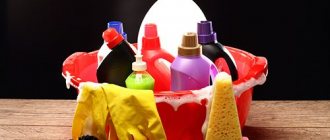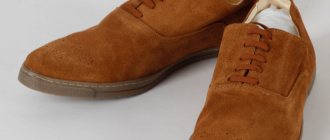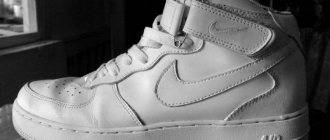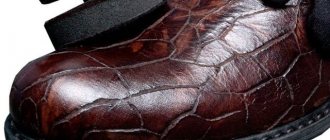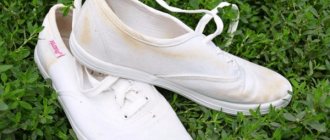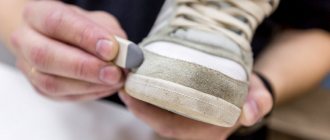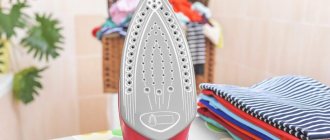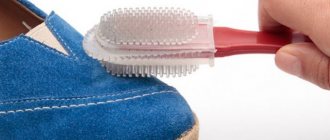The assortment of shoes includes thousands of types of models for all occasions. In addition to the obvious differences in styles, the models differ in the type of upper material.
Natural and artificial leather, polyester, leatherette, nubuck, suede, rubber - all kinds of materials are used by manufacturers to conquer the trade market.
Among summer models, shoes made from various types of fabric have not gone out of fashion for many years. Moccasins, clogs, sneakers, ballet flats, sandals, pantos, sneakers, shoes with fabric tops always look great.
White summer boots made of perforated fabric look very impressive. Consumers of all ages unconditionally fell in love with this type of footwear for a number of undoubted advantages:
- soft texture practically does not rub the skin of the feet in hot weather;
- the material provides ventilation for the shoes, the feet “breathe”;
- pleasant comfort when walking;
- The color range of the models makes it easy to choose clothes to match;
- fabric shoes are considered universal; they are used for sports, everyday activities, and going out.
The advantages of this type of shoe are obvious, but caring for them is also difficult. Leather shoes are easier to care for; they can be washed and cleaned in a matter of minutes with any detergent. Another thing is caring for fabric shoes.
Fabric moccasins, shoes and sneakers, despite their attractive appearance, instantly get dirty. In general, any fabric shoes must be carefully looked after. This is especially true for white shoes, let's be honest - such models are purchased only for one season.
If you wash and clean white shoes every day, then, despite careful care, they will invariably lose their original appearance. White sneakers or moccasins should be worn occasionally, as they say - on the boardwalk in dry weather.
Features of sneaker materials
Nowadays, shoes with white soles made of wear-resistant rubber or synthetic materials - filight, polyurethane, ethylene vinyl acetate, phylon have become very fashionable. They give sneakers and sneakers strength and elasticity. The materials for the soles are highly resistant to aggressive environmental influences. Despite this, during wear they become covered with various stains, become yellowish or acquire an unpleasant shade of gray.
Sometimes the sole has grooves around the perimeter, which complicates the situation with cleaning the shoes. To ensure that white sneakers last as long as possible, you need to regularly clean not only the upper, but also the sole. The material from which it is made is of great importance. A soft, damp cloth is ideal for cleaning the leather, while the rubber sole can be cleaned with a regular eraser or melamine sponge.
To prevent yellowish stains from appearing on the white sole, it is important to regularly wash off all contaminants.
What are the benefits of poplar buds?
Black poplar buds are very rich in biologically active substances with bactericidal, anti-inflammatory, antiallergic, diuretic, analgesic and antiseptic properties.
Interesting materials:
How to turn on a Philips steam iron? How to enable data transfer on iPad? How to enable data transfer on ZTE? How to enable page translation on Android? How to enable page translation in Firefox? How to enable page translation in Google Chrome on iPhone? How to enable page translation in Yandex? How to enable page translation in Chrome on iPhone? How to enable page translation on your phone? How to enable translation on Twitter on your phone?
How to remove yellowness from white sneaker soles
Usually even the dirtiest shoes can be restored to their original appearance. To do this, just clean it well. You can try to do the same with old sneakers whose soles have acquired a yellowish tint. However, cleaning the yellow color is not always possible, even if you take your shoes to the dry cleaner. The result depends on how the spots appeared.
- If the sole has acquired a yellow tint due to ingrained dirt or dust, then it will not be difficult to fix it.
- But the sole can also turn yellow if you constantly dry your shoes on a radiator (or near it). Leaving your sneakers in bright sunlight for several days will have the same effect. The whiteness of such a sole can only be restored by painting it with white acrylic paint. The painting agent must not be water-based.
To make the dye stick more firmly, you can dry the sole with a hairdryer. The effect will be long lasting and will not disappoint your expectations.
Good acrylic will not wash off. It can be dried with a hot hairdryer to fix the dye.
If stains on the white sole appear from ingrained dirt, then they can be easily wiped off using household products.
You can buy cleaning products for sneakers and other shoes using the link in the Lamoda store.
Why does the sole color change?
Dear reader! Pay attention to the peculiarity of the Chistulya-Info website - each article contains a selection of the best advice left by experienced housewives on thematic forums. Save time by reading ready-made collections. Use proven tips that work.
Advice from Chistyuli. Add this article to your bookmarks and useful information will always be at hand!
Before you find the most effective way to wash white soles on shoes at home, you need to establish the cause of the contamination. Attention: the article was written for the website Chistyulya.info. Publishing on other sites is theft of content. Read this and other similarly useful articles in the original source! Factors of “stain formation” include:
- road dust, dirt;
- change in the structure of the material, yellowing (occurs with every material when exposed to ultraviolet radiation);
- low quality raw materials;
- coloring agents: varnishes, markers, grass.
How to wash white soles from yellowness on shoes? Regular detergents or abrasives cannot cope with the yellow tint. For this purpose, special paints and cream paints are produced. They are applied to pre-cleaned dry soles. Here are some successful examples:
- Cochin Bianco Coccine
- Felice sole paint
- Leather paint Angelus Flat White
- Paint for white soles (Italy)
- Liquid cream paint for shoes white Silver Express
- Covering cream paint COCCINE
When choosing a product, pay attention: there are paints for matte and glossy surfaces. And also universal dyes.
How to whiten the soles of sports shoes and sneakers, read this link.
How to whiten the soles of sneakers at home
The use of folk remedies is an ideal way to independently clean shoes from dirt and yellowness. For this use:
- toothpaste (powder);
- hydrogen peroxide;
- citric acid;
- a mixture of soda and vinegar with water;
- nail polish remover;
- eraser or melamine sponge.
Toothpaste
For this method, it is better to choose a composition with a whitening effect without color additives.
- Use a stiff bristle brush and toothpaste to clean the surface.
- Wait 20 minutes.
- Rinse shoes thoroughly in warm running water.
Hydrogen peroxide
Treat problem areas with hydrogen peroxide (3%). This solution will return the sole to its ideal white color and carefully remove any stains.
Hydrogen peroxide is an excellent tool for whitening the soles of sneakers.
Lemon acid
Citric acid or lemon pulp will help remove the yellowish tint and gray deposits.
- Rub the problem areas thoroughly with powder or pulp.
- Leave for fifteen minutes.
- Wash well with clean water.
It is more convenient to apply citric acid with a toothbrush and it is better not to dilute it with water.
A mixture of baking soda, vinegar and water
There are three options for using baking soda and vinegar to remove stains from rubber.
- Wipe problem areas with a solution of vinegar and water in a ratio of 1:3.
- Prepare a paste of vinegar and soda in a ratio of 1.5:1, apply it with a sponge to the sole. When the mixture dries, wash it off with warm water.
- Thoroughly rub dirt with baking soda using a damp brush, removing dirt from all grooves on the rubber, and then rinse the shoes with water.
Nail polish remover or acetone
When using these products, excellent results are achieved, but they have a strong odor, which complicates the work. In addition, there is a risk of damage to the integrity of the sole. Therefore, before cleaning, it is necessary to carry out a quick test: apply the liquid to an inconspicuous small area. If no damage appears, you can use the product.
- Soak a cotton pad with acetone.
- Gently wipe the surface.
- Wash shoes thoroughly with clean water.
When using acetone, you need to take a white cloth, since the paint on colored fabric can dissolve under the influence of the products and stain the shoes.
Eraser or melamine sponge
You need to use a white eraser that does not leave streaks on the surface when erasing.
- Use an eraser to process the corrugated sole, not missing a single indentation, thoroughly removing yellowness, dirt and black stripes.
- When finished, wipe the product with a clean soft cloth.
There is no need to use water with this cleaning method. For one pair of shoes, you need to take a fairly large eraser, and if the surface of the sole is uneven, you will also need small pieces to clean the thinnest grooves. The hard side of the eraser can damage the structure of the material and leave unwanted marks. For this reason, you only need to use its soft side.
Using a melamine sponge is much easier: wet the sponge, wring it out and wipe the shoes with it. It is softer than an eraser and more pleasant for the hands, but is still a harsher product. This does not guarantee perfect cleanliness if the yellowness is deeply ingrained into the sole, but the shoes will look much whiter.
How to remove stains from grease, glue, marker, paint on the sole of sneakers
Heavy stains, such as marks from paint, markers, pens, grease or shoe glue, can be removed using the following methods:
- a solution of soda and lemon juice;
- ammonia.
Cleaning procedure:
- Treat the problem area with a solution of baking soda and lemon juice. After this, wash your shoes thoroughly in clean warm water.
- Mix 250 ml of water with ammonia (1 teaspoon). Treat the stain with the solution and wait ten minutes. After this, wipe the shoes with a dry soft cloth.
How to remove stains from grease, glue, marker, paint
If stubborn stains from greasy food, coloring compounds, markers and other aggressive substances appear on the surface of the sole, they need to be removed using more radical methods. A solution based on ammonia, soda and citric acid effectively fights stubborn stains:
- In a glass of water you need to dilute 25 g of acid and 2 tbsp. l. sodium bicarbonate.
- The solution is applied to a cotton pad or cloth and used to wipe problem areas.
- You can also add 1-2 tsp in water. ammonia, apply it to the contaminated areas and wash off after a couple of minutes.
If there are difficult stains, both solutions should be mixed and poured into a suitable container. Then you need to immerse the sole there for 20-30 minutes.
Clean the soles of sneakers using household chemicals
Household chemicals make it much easier to achieve your goal - to erase all dirt and remove yellowness. Whatever chemical you choose, shoes must first be prepared for cleaning:
- remove the top layer of dried dirt using a damp cloth;
- mechanically clean the sole from large pieces of debris;
- wash in warm soapy water.
It is better to use safe and simple remedies first, and if they do not work, then stronger ones.
First, try just washing with dishwashing detergent or laundry soap.
- Grate the soap and dilute it with water to form a paste-like mass.
- Using a brush, apply the paste to the sole and rub the stains.
- Let stand for about an hour and rinse well in running water.
Dishwashing liquid is used in the same way.
Laundry soap makes a good product for caring for white soles.
Using laundry detergents
Washing powder does a good job of removing yellowness from soles. To do this, use a mixture of it with vinegar and hydrogen peroxide.
- Mix the powder with hydrogen peroxide and vinegar in equal proportions.
- Apply the resulting mixture with a brush to the surface of the sole.
- Wait 15 minutes.
- Wash with plenty of clean water.
Oxygen-containing laundry detergents contain sodium percarbonate and other similar chemical compounds that easily break down and release oxygen during use. Under its influence, contaminants are oxidized and purified. In this case, no damage is caused to things.
- Soak the soles of sneakers (not higher) in this product for two hours.
- Wash thoroughly with plain water.
Stain remover
You should use a product for white fabrics so as not to disturb the structure of the sole material.
- Rub the sole with stain remover using a stiff bristle brush.
- Leave the shoes for 3-4 hours.
- Rinse the product thoroughly with warm water.
Yellowness from the sole is removed with a stain remover for white fabrics
If the rubber on the sole of your sneakers has turned yellow
Bleach will help make the condition of the white sole almost perfect. But it is advisable to use oxygen-containing products. They cope with almost all types of stains: grass stains, iodine and brilliant green, blood.
The reaction of materials to chemical cleaners may vary. To make sure that the chosen product is safe for the sole, you need to apply it to a small, inconspicuous area of the surface and wait a couple of hours. If no cracks or holes form, then you can safely begin work.
- Prepare a solution of bleach and water in a 1:2 ratio in a wide basin.
- Place the shoes in the basin so that the solution covers the sole without touching the top.
- Leave the sneakers for an hour and then check to see if the shoes have bleached.
- If the result is achieved, thoroughly rinse the solution from the sole; if not, put the shoes back in the basin for a while.
- Relief depressions, microcracks and curves can be additionally cleaned with a brush, removing remaining stains of dirt and yellowness.
When using liquid oxygen bleach, simply apply a thin layer and wait three hours. Then remove any remaining dirt using a soft, damp cloth and rinse the shoes with warm water.
For practically new shoes, you can use bleaching laundry detergent.
- Mix the powder with water to form a paste.
- Apply the resulting mixture to the sole and wait half an hour.
- Treat the product with a stiff bristle brush, removing dirt.
- Rinse everything off with water and wipe the shoes with a clean soft cloth.
You can buy cleaning products for sneakers and other shoes using the link in the Lamoda store.
Prevention
To prevent contamination, it is recommended to wash shoes only with warm water with minimal hardness. Excessively cold or hot compounds aggravate the problem, making the stains persistent.
After restoring its original appearance, the surface of the sole must be treated with white or transparent shoe polish. This will allow you to maintain the results for a long time.
It is forbidden to treat the sole with bleach and chlorine-containing solutions, as they increase the likelihood of the sole becoming yellow. Getting rid of such stains in the future will be problematic.
After each walk, be sure to wipe the soles with a damp cloth or soapy water - this will reduce the amount of dirt and simplify the process of removing them.
Well-groomed shoes look more beautiful and presentable than dirty ones covered with dust or yellow stains. Therefore, try to regularly monitor your favorite sneakers or sneakers, and also take into account all the recommendations for caring for them.
Is it worth trying to wash stains on the soles of sneakers in a washing machine?
The easiest way to clean your favorite shoes is by washing them in the machine. This method does not always give the expected result, and sometimes it can be completely useless and unsafe for shoes. After machine washing, sneakers tear and lose shape much faster.
In addition, there is a danger that the snow-white sole will acquire a yellowish tint and begin to peel off. However, if you still decide to go with a washing machine, then you need to follow a few simple rules.
- Before loading sneakers or sneakers into the washing machine, you must remove the insoles, laces and other removable parts.
- It is necessary to remove adhering dirt with a brush and soapy water and dry. The sole tread should be especially carefully cleaned of small stones and sand, as their entry into the machine can damage the drum, pipe and filter.
- It is strictly forbidden to soak shoes before washing. When dried, it will lose its shape.
- It is better to set the delicate mode with minimal speed and additional rinsing. The spinning and drying must be turned off, otherwise the sneakers will get wet and come apart.
- The optimal water temperature is 40 °C.
- Shoes should be washed in a special bag, and some other things should be placed in the drum to soften the shock during rotation.
It is better to dry sneakers after machine washing in the usual way at room temperature, stuffing them with crumpled newspapers. The paper will prevent deformation during drying and absorb excess moisture. You can also dry your shoes using special dryers.
When the shoes are completely dry, apply a water-repellent agent to them. It is strictly forbidden to dry sneakers and sneakers on a heating radiator or with a hair dryer . This can lead to deformation, the sole will turn yellow and it will be more difficult to bleach it.
